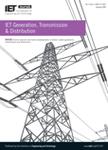版权所有:内蒙古大学图书馆 技术提供:维普资讯• 智图
内蒙古自治区呼和浩特市赛罕区大学西街235号 邮编: 010021

作者机构:Nanyang Technol Univ Sch Elect & Elect Engn Singapore 639798 Singapore Nanyang Technol Univ Rolls Royce NTU Corp Lab Singapore Singapore Rolls Royce Elect Rolls Royce Singapore
出 版 物:《IET GENERATION TRANSMISSION & DISTRIBUTION》 (IET发电,输电与配电)
年 卷 期:2020年第14卷第25期
页 面:6348-6358页
核心收录:
主 题:energy management systems integer programming ships linear programming power generation dispatch optimisation energy storage rule-based operation task-aware energy management ship power systems operation task-aware energy management strategy main engines diesel-electric engines energy storage systems task-dependent objectives storage units rule-based decisions operational task requirements optimisation stage operational constraints optimisation problem mixed-integer linear programming model rule-based decision variables different operation task sequences ship topologies optimal energy dispatch
摘 要:This study proposes an operation task-aware energy management strategy for ship power systems that consist of main engines, diesel-electric engines, and energy storage systems. The proposed strategy aims to meet the fuel consumption and task-dependent objectives of the vessel by optimally dispatching the generation and storage units. Firstly, rule-based decisions are made based on the operational task requirements and specifications by the classification societies. Then, in the optimisation stage, these decision variables are used as inputs to formulate and update the operational constraints and the objectives of the optimisation. The optimisation problem is formulated as a mixed-integer linear programming model, and with the help of rule-based decision variables, the problem can be efficiently solved by the exhaustive search algorithm. Four case studies with different operation task sequences and ship topologies are performed to demonstrate the effectiveness of the dispatching scheme. Furthermore, the results indicate the simplicity and practicality for the actual implementation, as well as flexibility and applicability of the proposed optimal energy dispatch for different types of vessels.